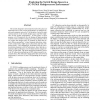Free Online Productivity Tools
i2Speak
i2Symbol
i2OCR
iTex2Img
iWeb2Print
iWeb2Shot
i2Type
iPdf2Split
iPdf2Merge
i2Bopomofo
i2Arabic
i2Style
i2Image
i2PDF
iLatex2Rtf
Sci2ools
IPPS
2000
IEEE
2000
IEEE
Exploring the Switch Design Space in a CC-NUMA Multiprocessor Environment
The switch design for interconnection networks plays an important role in the overall performance of multiprocessors and computer networks. It is therefore crucial to study various factors in the switch design space and their influence on the system performance. In this paper we first propose a 4-D framework for the design of input queuing switches with wormhole routing and virtual channels. Then we explore the design space to examine in detail the impact of four parameters: virtual channel allocation, intraswitch connectivity, buffer space allocation and link arbitration policy. Our simulations, performed with an execution driven simulator with ILP processors, show that the cumulative effect of the four switch enhancements ranges between 7% and 38%. The most important parameter proves to be VC allocation method (up to 28% improvements in execution time). The other three bring about the same level of performance: between 1% and 7% depending on the application.
| Added | 31 Jul 2010 |
| Updated | 31 Jul 2010 |
| Type | Conference |
| Year | 2000 |
| Where | IPPS |
| Authors | Marius Pirvu, Nan Ni, Laxmi N. Bhuyan |
Comments (0)

